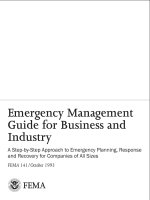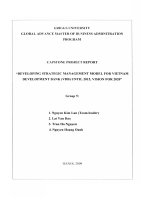Strategic management planning for domestic and global competition 14th ed pearce robinson chapter 10
Bạn đang xem bản rút gọn của tài liệu. Xem và tải ngay bản đầy đủ của tài liệu tại đây (499.57 KB, 30 trang )
Chapter 10
Implementation
© 2015 by McGraw-Hill Education. This is proprietary material solely for authorized instructor use. Not authorized for sale or distribution
in any manner. This document may not be copied, scanned, duplicated, forwarded, distributed, or posted on a website, in whole or part.
Learning Objectives
•
•
•
•
Understand how short-term objectives are used in strategy implementation
Identify and apply the qualities of good short-term objectives to your own experiences
Illustrate what is meant by functional tactics and how they are used in strategy implementation
Gain a general sense of what outsourcing is and how it becomes a choice in functional tactics
decisions for strategy implementation
• Understand what policies are and how to use them to empower operating personnel
• Understand the use of financial reward in executive compensation
• Identify different types of executive compensation and when to use each in strategy implementation
Short-Term Objectives
• Short-term objectives
• measurable outcomes achievable or intended
to be achieved in one year or less.
Short-Term Objectives (contd.)
• Short-term objectives “operationalize” long-term
objectives.
• Discussion about and agreement on short-term objectives
help raise issues and potential conflicts within an
organization
• Short-term objectives assist strategy implementation by
identifying measurable outcomes of action plans or
functional activities, which can be used to make feedback,
correction, and evaluation more relevant and acceptable
Ex. 10.2
Potential Conflicting Objectives and Priorities
Short-Term Objectives
Short-Term Objectives provide:
•
Specificity
•
Time frame for completion
•
Who is responsible—Accountability
Qualities of Effective Short-Term Objectives
• Measurable
• Priorities
• Cascading: From long-term objectives to
short-term objectives
Qualities of Effective Short-Term Objectives
(contd.)
• Measurable
• Measurable activity
• Measurable outcomes
• Priorities
• Simple ranking
• Relative priority / Weights
• Linked to Long-Term Objectives
• Cascading effect
Ex. 10.3
Creating Measurable Objectives
Ex. 10.4
Milliken Global Environmental Objectives
Functional Tactics
• Detailed statements of the “means” or activities that
will be used by a company to achieve short-term
objectives and establish competitive advantage.
Functional Tactics (contd.)
• In a sense, functional tactics translate thought into
action
• Every value chain activity in a company executes
functional tactics that support the business’s
strategy and help accomplish strategic objectives
Functional Tactics (contd.)
• Functional tactics are different from business
or corporate strategies in three fundamental
ways:
– Specificity
– Time horizon
– Participants who develop them
Ex. 10.5
Specificity in Functional Tactics vs. Business
Strategy
Outsourcing Functional Activities
• Outsourcing is obtaining work previously
done by employees inside the company from
sources outside the company
Ex. 10.7
Outsourcing is Increasing
Empowering Operating Personnel: Policies
•
Empowerment is the act of allowing an
individual or team the right and flexibility to
make decisions and initiate action
Empowering Operating Personnel: Policies
(contd.)
• Policies are broad, precedent-setting
decisions that guide or substitute for
repetitive or time-sensitive managerial
decision making.
Creating Policies That Empower
• Policies establish indirect control over
independent action
• Policies promote uniform handling of similar
activities
• Policies ensure quicker decisions by standardizing
answers to recurring questions
• Policies institutionalize basic aspects of
organization behavior
Creating Policies That Empower
(contd.)
• Policies reduce uncertainty in repetitive and day-today decision making
• Policies counteract resistance
• Policies offer predetermined answers to routine
problems
• Policies afford managers a mechanism for avoiding
hasty decisions
Innovation Time Out Policy
• Refers to what is usually an official company
guideline, or policy, establishing an amount of time
during each work week an employee, or specific
types of employees (e.g., engineers) can at their
choice set aside from their regular assignment to
work on innovative, new ideas they are thinking
about.
Advantages of Formal, Written Policies
1. They require managers to think through the policy’s meaning, content,
and intended use
2. They reduce misunderstanding
3. They make equitable and consistent treatment of problems more likely
4. They ensure unalterable transmission of policies
5. They communicate the authorization or sanction of policies more clearly
6. They supply a convenient and authoritative reference
7. They systematically enhance indirect control and organization wide
coordination of the key purposes of policies
Bonus Compensation Plans
• Company shareholders typically believe that the goal of a
bonus compensation plan is to motivate executives and
key employees to achieve maximization of shareholder
wealth.
• However, the goal of shareholder wealth maximization is
not the only goal that executives may pursue.
• An executive compensation plan that contains a bonus
component can be used to orient management’s decision
making toward the owners’ goals.
Types of Bonus Compensation Plans
•
Stock options
The right, or “option” to purchase
company stock at a fixed price at
some future
Bonus Compensation Plans (contd.)
• Restricted stock
Stock given to an employee who is
prohibited or “restricted” from selling the
stock for a certain time period and not at
all if they leave the company before that
time period.









